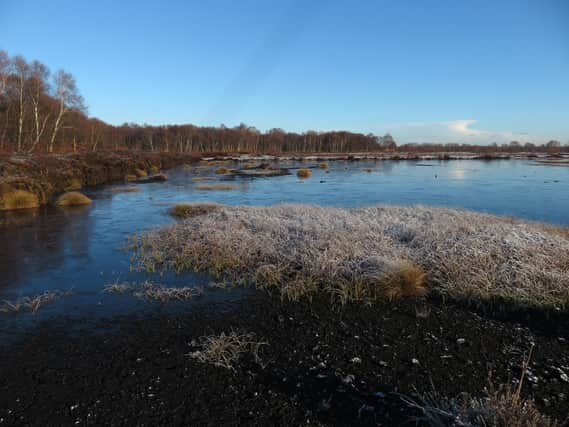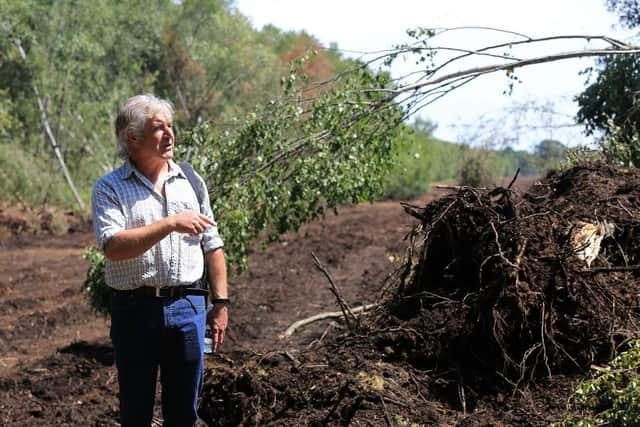Hatfield Moor Nature Reserve re-opens sections to the public weeks after the devastating fire which destroyed parts of the important peatland habitat


A full assessment of the worst-hit areas is still in progress with the on-site team from Natural England which runs the reserve carrying out a full survey on the reserve’s infrastructure.
But a little over a month after the fire broke out on May 17, safe areas have been opened up to visitors with signposting away from the fire-damaged areas.
Advertisement
Hide AdAdvertisement
Hide AdPaul Duncan, Natural England Yorkshire area manager, said: “As part of the recovery of the site, we need to repair the damage to infrastructure – tracks, culverts and water control structures were damaged as a result of the fire, and there are many trees that need to be assessed for their safety.”


The wildlife habitat, which is part of the larger Humberhead Peatlands National Nature Reserve, is home to a “unique range” of animals, insects and plants including the critically endangered nightjar.
South Yorkshire and Humberside crews battled for more than three weeks to bring the fire under control, working with Natural England to build in fire controls in a bid to save some of the most valuable parts of the site.
Mr Duncan said it was thanks to the efforts of the Fire Service and Natural England staff on site that they were able to prevent any fire damage to large parts of the moors.
Advertisement
Hide AdAdvertisement
Hide Ad“Even within the areas where the fire spread, management efforts to re-wet the peat prevented or limited the severity of the damage. This will allow important species to re-colonise fire damaged parts of the site as they recover and are restored.”
He said that looking ahead they would be consulting with South Yorkshire and Humberside Fire Services, Doncaster Council and adjacent landowners about building the fire control measures put in place as part of the fire response, into the broader recovery and management plan.
Mr Duncan said as they were still trying to assess the full extent of the damage it was difficult to put timescales on recovery and restoration.
However, he said the scale of the impacts were such that it was likely the restoration work may take years.
Advertisement
Hide AdAdvertisement
Hide AdHatfield Moor is a remnant degraded lowland raised bog and along with Thorne, Goole and Crowle Moors, forms part of the Humberhead Peatlands. The Peatlands are a remnant of a large wetland that occupied the floodplain of the Humberhead Levels thousands of years ago.
Lowland peatbog is a threatened habitat and Humberhead, as the UK’s largest lowland peatbog complex stretching to almost 3,000 hectares, is a site of international importance and a Special Area of Conservation.
As home to the nocturnal nightjar, it has also been declared a Special Protection Area under the European Birds Directive.
The chairman of Natural England, Tony Juniper, visited the site earlier in the month to see the damage first hand and discuss recovery plans.
Advertisement
Hide AdAdvertisement
Hide AdDuring his visit he stressed the need for a focus on restoration and putting a plan in place for the reserve’s recovery.
He also said there had been one small piece of good news as the nesting areas used by the nightjars appeared to have escaped the fire.
Mr Juniper described the fire as a “setback” but said they had brought it back from where it was after years of extraction so had to hope they could restore it again.
Before Natural England secured funding through the European Union’s LIFE+ programme for a restoration project, the peatland – and the natural carbon sink it creates – had been destroyed by industrial-scale peat extraction.
Advertisement
Hide AdAdvertisement
Hide AdExtraction ceased in 2004 and the project got underway in 2014 with a completion date of 2018, which was then extended to June 2019.
Part of the ongoing management of the site has been re-wetting sections of peat and the Natural England team said the areas where this had been carried out were less affected by the fire.
But Natural England said re-wetting degraded lowland raised bog, particularly a site where the hydrological systems have been as heavily modified as Hatfield, is a long-term undertaking which means there are some areas that have yet to be fully restored and where the peat remains relatively dry, particularly during hot summers.
Speaking at the time of his visit, Mr Juniper said he had hoped the amount of water the soil had accumulated through the wet winter may have also offered some protection.
Advertisement
Hide AdAdvertisement
Hide AdHe raised the importance of restoring the peatland so it can provide its natural function as a carbon sink, particularly in light of the extreme weather conditions we have been experiencing.
“We have had record-breaking dry, sunny weather and this follows a period of record-breaking rainfall. We are seeing climate change projections turning into a reality,” he said.
“The peat provides a massive carbon store which we need to protect and the reserve supports a unique range of animals, insects and plants.”
He said looking at how to keep the area moist was going to be one of the key issues which needed to be considered.
Advertisement
Hide AdAdvertisement
Hide Ad“It is particularly important as we have such big long-term climate challenges as a country, and nature reserves need to be resilient to these kind of events.”
Both Mr Juniper and Mr Duncan stressed the importance of visitors being extra vigilant when they were out and about with Mr Duncan adding that it was important people were aware of the Countryside Code.
He said this included protecting the natural environment by leaving no trace of your visit, taking all litter home and not having barbecues or fires, and never discarding a lit cigarette.
Two car parks have been opened for visitors to the reserve which can be found at Hatfield Moors at Boston Park off the A614 between Hatfield Woodhouse and Blaxton (main car park). Postcode DN7 6DS and a smaller car park at Ten Acre Lake, accessed down a rough track off Remple Lane, off the A614 in Hatfield Woodhouse. Postcode DN7 6DT.
For more information about the Countryside Code, go to www.gov.uk/government/publications/the-countryside-code